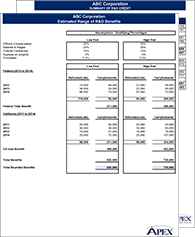RESEARCH & DEVELOPMENT TAX CREDIT
It pays to be innovative
Everyday, your business is taking a risk.
Whether you’re researching a new drug, creating a mobile app, refining a mold or building a skyscraper, you’re doing more than just running a business.
You’re taking a leap of faith that doesn’t guarantee you’ll get paid for your hard work.
That’s why the Research & Development (R&D) tax credit exists.
REMEMBER THE EIGHTIES
It started back in 1981. President Reagan enacted the Research & Experimentation tax credit as a way to reboot the American auto manufacturing industry. It’s now turned into an estimated $12 billion credit that helps more than 12,000 American businesses compete in a complex global economy.
On December 15, 2015, President Obama cemented the R&D tax credit as a permanent provision of the IRS tax code, and made two major changes that significantly increased its accessibility to small businesses.
First, businesses with less than $50 million in gross receipts can use the credit to offset alternative minimum tax (AMT).
Second, start-up businesses with no income tax liability can apply their R&D tax credits to their payroll tax liability, a tax savings that can be as much as $250,000 a year.
The estimated amount of R&D tax credits that the IRS
provided to US businesses.
Top X-axis represented in billion dollars.
HOW THE R&D TAX CREDIT WORKS
Dollar for dollar
The R&D tax credit provides businesses with an actual credit on the taxes they pay. It is one of the most valuable credits available because it is a dollar-for-dollar reduction in tax liability. There are no caps, no application fees, no restrictions on how you can use your credit dollars.
The R&D tax credit only applies to activities that the IRS considers “research and development,” which is more prevalent than you might think. Laboratories and high technology firms are obvious candidates, but did you know that architectural, engineering, software and many manufacturing companies are also eligible?
THE FOUR PART TEST
Detailed analysis of your business.
Determining whether a business activity qualifies for R&D is based on a broad set of definitions known as “The Four Part Test.” This is a subjective analysis that is open to interpretation, which is why so many different types of business qualify for the R&D tax credit. It is our job to substantiate, document and prove that some portion of your business activity involves R&D.
QUALIFIED RESEARCH EXPENSES (QRE)
Basic units of R&D Tax Credit.
The QRE is the basic unit of the R&D tax credit. QREs are derived from salaries, supplies and contractor expenses. About 80 percent of the tax credit you receive comes from salaries. As a part of the R&D tax credit study process, we determine whether an activity counts towards R&D, the employees involved with that activity, the amount you pay them and the portion of their time that is dedicated to that activity. That’s why payroll data is essential to proper calculation of QRE.
HOW MUCH IS THE R&D TAX CREDIT WORTH?
The size of the R&D tax credit varies greatly because it depends on the amount of R&D activity that can be quantified. An analysis of our client base shows that the average size of the federal R&D tax credit in one year is approximately 1% of a company’s annual revenues. However, credits can be claimed retroactively for up to three years and 36 states provide an additional R&D credit.
Apex Advisors Client R&D Tax Credit Value (2012, Federal R&D only)
THE APEX ADVISORS R&D TAX CREDIT PROCESS
From study to processing
We utilize a comprehensive process that ensures all possible R&D activities are considered and calculated with accuracy. The Preliminary Assessment is provided to companies at no cost. The estimated duration of all phases is 2 to 3 months.
Architecture & Engineering
The architecture and engineering industry is ripe with R&D activity.
In fact, Apex Advisors specializes in conducting R&D tax credit studies for architects and engineers due to the complex nature of their projects. More importantly, architects and engineers need to recognize that the nature of their design work fits precisely within the definition of R&D.
Manufacturing
Manufacturing is a diverse industry with a wide variety of R&D activity.
From injection molding to electronic components to food processing, manufacturing can take many forms and requires thorough analysis to understand how and where R&D activities can be found. Apex Advisors has expertise in over 60 categories of manufacturing and can confidently determine your R&D tax credit value.
Software
Software firms have large amounts of R&D relative to their size.
Software development has a high concentration of R&D activity and the salaries of these types of employees can generate some of the highest amounts of R&D tax credits compared to other industries. Even a small to medium size firm can qualify for a significant amount of credits.
TRY A FREE SAMPLE OF OUR SERVICES
Still confused whether R&D tax credits make sense for your business? Already using another firm for R&D tax credit studies but curious to see what we can do? We’re offering to conduct a Preliminary Assessment of your business at no cost. We’ll analyze your tax returns and determine an estimated range of tax credit benefits. No risk, no commitment, no problem.


